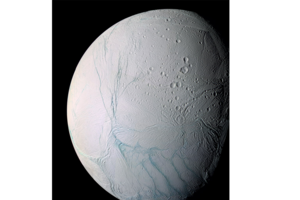Saturn moon has a global ocean, say NASA scientists. Could it harbor life?
Locked beneath the icy crust of Enceladus, Saturn's sixth-largest moon, is a global ocean that could potentially harbor life, say NASA scientists.

This undated photo provided by NASA on April 2, 2014 shows Saturn's moon Enceladus. The "tiger stripes" are long fractures from which water vapor jets are emitted.
NASA/JPL/Space Science InstituteAP Photo/File
Scientists at NASA say they have confirmed that the liquid ocean beneath the icy crust of Saturn’s sixth-largest moon, Enceladus, covers the whole moon. The discovery, made using images from NASA’s Cassini orbiter, holds implications for the possibility that life could evolve there, and may have done so already.
"This is a major step beyond what we understood about this moon before, and it demonstrates the kind of deep-dive discoveries we can make with long-lived orbiter missions to other planets," said co-author Carolyn Porco, Cassini imaging team lead at Space Science Institute, Boulder, Colorado, and visiting scholar at the University of California, Berkeley, in a NASA statement.
Past observations of Enceladus have shown icy geysers and deep reservoirs. This new finding “implies the fine spray of water vapor, icy particles and simple organic molecules Cassini has observed coming from fractures near the moon's south pole is being fed by this vast liquid water reservoir,” according to the statement. The results of these findings will be published in the online science journal Icarus.
Leading scientists associated with the Cassini orbiter made the discovery after hypothesizing about the wobble in Enceladus’ orbit as it circles Saturn. They analyzed and mapped images of this planetary moon dating back to mid-2004 in order to accurately measure changes in Enceladus’ rotation.
As a result of this research, they found Enceladus has a tiny, but measurable, wobble as it orbits Saturn, both because of the icy moon’s less-than-spherical shape and Saturn’s own gravitational pull. Past observations of Cassini data pointed to the presence of a sea underneath the moon’s southern pole, with the possibility that it may be global. This new investigation, in conjunction with the findings regarding Enceladus’ orbit, confirms the sea’s global cover.
"This was a hard problem that required years of observations, and calculations involving a diverse collection of disciplines, but we are confident we finally got it right," said Peter Thomas, a Cassini imaging team member at Cornell University in Ithaca, New York, and lead author of the paper, in the statement.
The discovery that Enceladus holds a global sea underneath its icy surface may also mean that it was once hospitable to life, and may still be.
The criteria for a habitable moon, according to Sarah Ballard, NASA Carl Sagan fellow at the University of Washington in Seattle, are that “[t]he moon also can't be too far away from the host planet or we'll risk venturing outside of the planet's magnetic shield, which protects it from dangerous solar radiation,” she told The Takeaway radio program. On the other hand, “if the moon is too close to the host planet, then reflected light and radiation off the planet's surface would make conditions on the moon too hot for life.”
Enceladus, which was discovered in 1789 and named for the giant in Greek mythology, isn’t the only candidate on scientists’ list of moons with environments that could host life. Scientists at NASA are planning a mission to Jupiter's moon, Europa to investigate its potential, as that moon also seems to have a liquid ocean locked beneath ice. Two other Jovian moons, Ganymede and Callisto, may also have briny, liquid oceans beneath their rocky crusts. And Saturn’s largest moon, Titan, is the only body in our solar system other than Earth known to have stable bodies of liquid on its surface.

